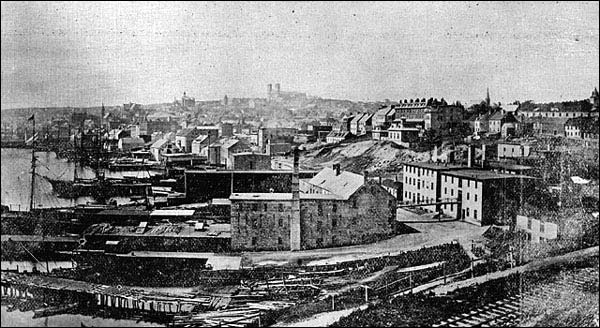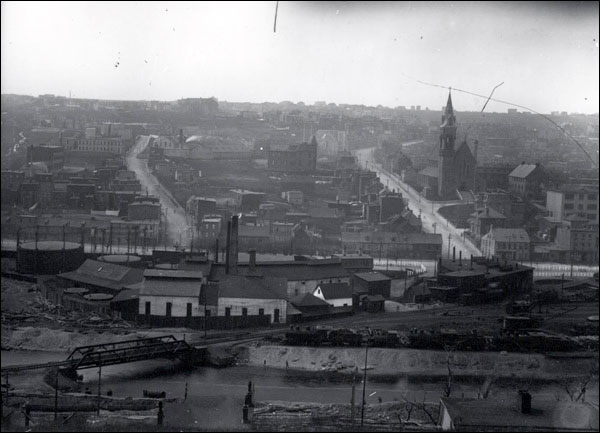Manufacturing Growth in St. John's 1870s-1914
St. John's has been a major service and supply centre since European settlement began, as well as one of Newfoundland's primary ports for importing goods and exporting fish. St. John's was therefore home to many trades and industrial activity, and the area around the harbour became increasingly busy as warehouses, wharves, and workshops were constructed to serve the fishing industry and the population. Until the second half of the 19th century, most industrial activity in St. John's was that common to port cities, such as sail making, pump and block making, coopering (barrel making), and ship repair. Blacksmiths, tinsmiths, and carpenters were also common, usually working in their own small workshops.
From the 1870s, however, the manufacturing sector grew considerably, and large factories using powered machinery and mass production techniques became more common. Many of these establishments produced consumer goods for the local market - bakeries, confectionaries, breweries, and tobacco factories. These goods replaced costly imports and provided local jobs. For example, the colony had been dependent upon imports of hard bread, or ship's biscuit, from the United States, England and Germany until the Rennie brothers from Scotland opened a flour mill and bakery in 1835. The products of Rennie's Mill, as it became known, as well as Vail's Steam Bakery which opened in the 1850s, replaced imported hard bread by 1900. Another example is the manufacture of margarine, or butterine as it was then known. Not having a large dairy industry, Newfoundlanders depended upon expensive imported butter. A margarine factory opened in 1883 to provide a suitable, cheaper alternative.

Clothing
Clothing manufacturers also began to produce goods for the home market. While homemade clothing made of locally available material such as wool and sealskin was common, most clothing and all cloth and textiles had to be imported. There were tailors and dressmakers in St. John's, but they mainly focused on making gentlemen's and ladies' clothing from imported textiles, and did not supply the fishing industry's demand for durable work clothes and waterproof outerwear. Although most clothing continued to be imported, firms such as the Newfoundland Clothing Company (incorporated in the mid 1890s) did a substantial business, using imported cloth and material to make woolen and oiled clothing suitable for the fishing industry. Also important were shoe and boot manufacturers, including the Newfoundland Boot and Shoe Company, the Archibald Boot and Shoe Company, and D. Smallwood and Sons. Leather tanneries, such as the West End Tannery, Rennie's River Tannery, and the Sudbury Seal and Leather Manufacturing Company developed largely to supply the boot and shoe industry. The Standard Manufacturing Company, founded in 1902, also made oiled clothing, but was better known for soap, dyes, and paint.
Heavy Industry
Small foundries, metal working shops and blacksmiths had operated in the city during the 18th and 19th centuries, but industrial metal working, producing items such as nails, stoves, and ship fittings like hawser pipes and railings, now began to develop. Charles Fox Bennett built a large iron foundry near Riverhead as early as 1827, and brought John Angel from Nova Scotia to manage it in 1847. Bennett's foundry was destroyed by fire in 1856, at which point Angel established his own foundry nearby. Angel and his sons operated the foundry on Hamilton Avenue (at the present-day intersection with Alexander Street) under various company names, absorbing Bennett's rebuilt foundry in 1870 and eventually becoming the Consolidated Foundry in 1886. The St. John's Nail Manufacturing Company opened in 1883. The two companies merged as United Nail and Foundry in 1930, and stayed in business until 1982, replacing much of the work once done by blacksmiths and other metalworkers.
The Angel Nail Foundry, as it was commonly called, was not the only important industry in the west end of St. John's. There were several small shipyards in the mid 19th century, but a recognized need for a proper, modern dry dock developed, especially as large steamers became increasingly common from the 1860s. The colonial government therefore funded the construction of a large dry dock in the harbour's west end. It opened in 1884, and employed metal workers, carpenters, caulkers and divers. In 1898 the dry dock became part of the assets of the Reid family (later the Reid Newfoundland Company), who were responsible for the railway's construction and operation. The car sheds of the St. John's Street Railway Company (another Reid subsidiary), which started operation in 1900, were also located in the west end, near the site of the new railway terminal, which opened in 1903.
Transportation and Trades
The changes in transportation that accompanied the industrial revolution, which began replacing wooden sailing ships with steel steamships, meant that traditional industries and trades were no longer in high demand. Although Newfoundland maintained a sizable sailing schooner fleet for many decades into the 1900s, the trades of sailmaking and pump and block making, which were never particularly large in the city in the first place, had essentially died out by the turn of the 20th century. Rope making survived, however, as even steamships need rope for mooring lines and tackle. Rope, twine and fishing nets were also essential items for the fishery. Local attempts to manufacture rope failed until the Colonial Cordage Company was established in 1882. This became one of the most successful manufacturing enterprises in Newfoundland, employing well over a hundred people until it closed after Confederation. Located near Mundy Pond, the company's premises were notable for the ropewalk, a building only a few metres wide but several hundred metres long where the rope was made. Although Colonial Cordage is now gone, Ropewalk Lane remains an important business street in the Mundy Pond area.
Cooperages, or barrel-making shops, made most of the packaging needed for the export of salt fish during this period, and are notable for being one of the few industries that relied mainly on local rather than imported raw material, buying most of the necessary birch, spruce, and fir from local sawmills. Most large merchant houses maintained cooperages, and independent shops existed as well. Merchants attempted to mechanize and consolidate cooperage operations, and between 1900 and 1909 established the St. John's Steam Cooperage, the Avalon Steam Cooperage Company, and the Northern Stave and Heading Company. The expense of mechanization, the seasonal nature of the work, and opposition from the Cooper's Union prevented any long term success, however, and all three of these factories shut down within a few years. Coopering remained a necessary trade well into the 20th century.
The West End
By the end of the 19th century, the downtown west end was increasingly becoming the city's industrial heart. C.F. Bennett's sawmill, brewery, and ironworks had all been located in the west end, and the gas works opened there in 1845. The dry dock reinforced its importance, and a new railway terminus was built there between 1898 and 1903. St. John's harbour was then considerably larger than it is today (vessels could go as far west as the foot of Patrick St.), and the station and the rail lines were built on pilings. Eventually the area west of the dry dock was completely filled in (except for a narrow channel for the Waterford River) to form the extensive train yards, machine shops and warehouses built for the railway. Much of the railway's rolling stock and engines were manufactured, assembled and/or repaired in the west end yards. The Great Fire of 1892, which destroyed much of the east end but left the west end untouched, also forced the relocation of businesses to the west end.

At the end of the 19th century, most of the population of Newfoundland lived in rural outport communities engaged in fishing, but the city of St. John's, while still a major fishery supply and importation centre, had also developed a small but important industry producing goods for the local market. Many industries, however, depended on protective tariffs for survival, and the colony remained heavily dependent upon imports. In the 20th century some local manufacturers gave up because the domestic market was too small to continue, and protective tariffs ended with confederation in 1949.
Nevertheless, the growth of industry was apparent, especially in the west end, and the increase in land-based industries at least partially turned St. John's from a merchant capital city focused on the fishery to the primary site of commerce, manufacturing, and administration in Newfoundland. The period 1870 – 1914 saw larger factories replacing most small firms in the production of goods for the local market, and by 1911 about 9 percent of the city's workforce was engaged in manufacturing of some kind. This may seem low, but it should be noted that many people also worked as longshoremen, clerks, or officials. Although the harbour and port were still the heart of the city's economy, people were being drawn away from the fishery to work in offices, factories, or the railway, and by the turn of the 20th century much of the city's 30,000 people were engaged in work on solid ground.




